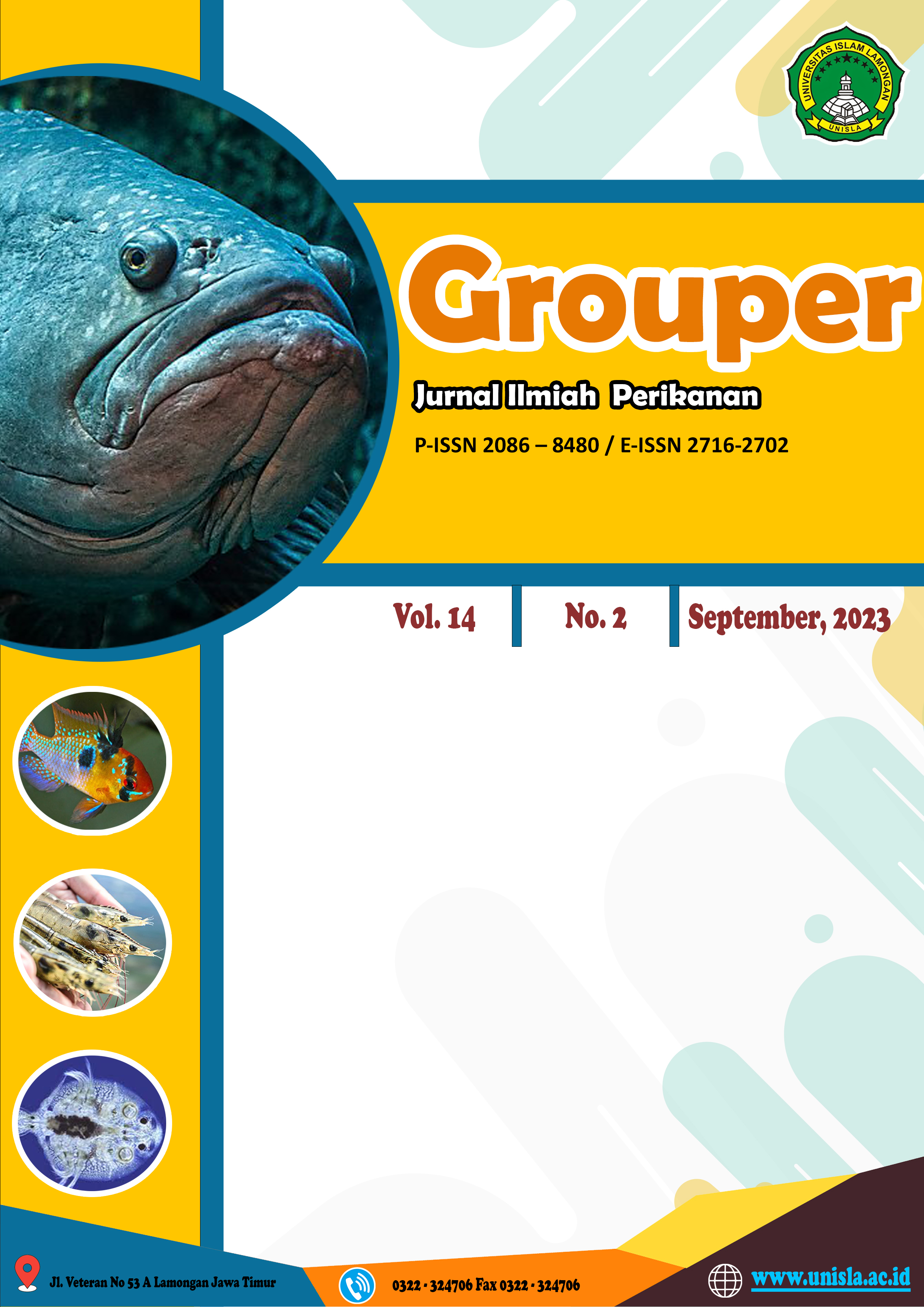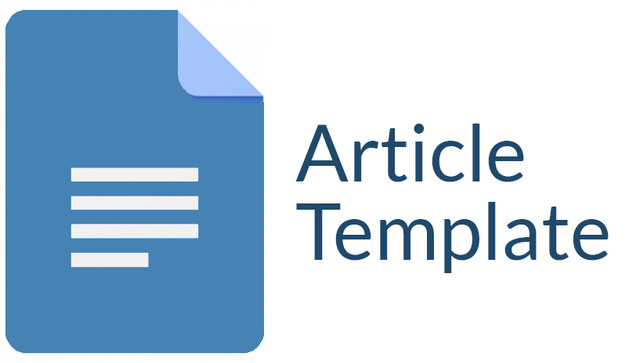Proporsional alih fungsi lahan mangrove untuk kawasan budidaya dalam perspektif mitigasi perubahan iklim
DOI:
https://doi.org/10.30736/grouper.v14i2.158Keywords:
Stok karbon, Budidaya, Manajemen Ekosistem Mangrove, Mitigasi Perubahan IklimAbstract
Pengelolaan ekosistem mangrove umumnya terdiri dari pengelolaan konservatif dan pengelolaan destruktif. Salah satu pengelolaan destruktif yang paling berpengaruh terhadap degradasi mangrove adalah alih fungsi lahan menjadi tambak. Penyerapan karbon mangrove menurun dan emisi gas rumah kaca meningkat seiring dengan konversi mangrove. Disisi lain, manfaat ekonomi dari kegiatan tambak sangat menjanjikan bagi pelaku usaha. Perdebatan antara mempertahankan ekologi atau mengutamakan keuntungan ekonomi terus bergulir. Analisis ini bertujuan untuk menentukan proporsional alih fungsi lahan mangrove menjadi tambak dalam perspektif mitigasi perubahan iklim. Hasil analisis menunjukkan bahwa alih fungsi lahan mangrove menjadi tambak pada proporsi tersebut dapat dilakukan pertimbangan keuntungan ekonomi dengan tetap menjaga optimasi fungsi penyerapan karbon. Stok karbon yang hilang akibat konversi dapat diperoleh melalui budidaya tambak udang. Kegiatan budidaya mampu menyerap CO2 hingga 25% dari serapan karbon mangrove melalui penyerapan fitoplankton. Selain itu, emisi gas CH4 yang dihasilkan tambak tradisional, semi intensif, dan intensif juga relatif rendah yaitu berkisar 0.0009 – 0.0264 mg m2 ha-1. Stok karbon mangrove yang dapat dikonversi menjadi tambak yang memiliki nilai karbon awal sebesar 261.9-490.12 Mg C ha-1 adalah 99.82-227.03 Mg C ha-1. Konversi tersebut dapat dilakukan untuk pembukaan lahan atau pengembangan kawasan budidaya. Namun apabila nilai stok karbon pada suatu ekosistem lebih rendah dari nilai stok karbon minimal (<261,9 Mg C ha-1) maka kegiatan budidaya dapat dilakukan pada lahan eksisting dan tidak melakukan konversi mangrove, sebaliknya harus dilakukan rehabilitasi mangrove sehingga stok karbon dapat meningkat. Jenis spesies mangrove yang direkomendasikan untuk direhabilitasi adalah R. stylosa, R. apiculata. dan R. mucronata.Â
Downloads
References
Assessment of species diversity, biomass, and carbon sequesteration potential of a natural mangrove stand in Samar, the Philipinnes. For. Scie. Techno. 10: 1-8.
Abrantes, K., Sheaves, M., 2009. Food web structure in a near-pristine mangrove area of the Australia Wet Tropics. Estuar. Coast. Shelf Sci. 82(4): 597-607.
Adame, M.F., Santini, N.S., Tovilla, C., Lule, A.V., Castro. L., Guevara, M., 2015. Carbon stock and soil sequestration rates of tropical riverine wetlands. Biogeosci. 12: 3805-3818. doi:10.5194/bg-12-3805-2015
Adame, M.F., Cherian, S., Reef, R., Stewart,K.B., 2017. Mangrove root biomass and the uncertainty of belowground carbon estimations. For. Ecol. Manage. 403: 52-60.
Alemaheyu, F., Richard, O., Wasonga, M.K., 2014. Assesment of mangroves covers change and biomass in Mide Creek, Kenya. Open J of For, (4):398-413.
Allen, D.E., Dalal, R.C., Rennenberg, H., Schmidt, S., 2011. Seasonal variation in nitrous oxide and methane emissions from subtropical estuary and coastal mangrove sediments, Australia. Plant Biol. 13: 126 – 33.
Alongi, D.M., 2008. Mangrove forests: resilienci, protection from tsunamis, and responses to global climate change. Estuar. Coast. Shelf Sci. 76: 1-13.
Alongi, D.M., Mukhopadhyay, S.K., 2015. Contribution of mangrove to coastal carbon cycling in low latitude seas. Agricul. For. Meteorol. 213: 266-272
Amaral, V., Penha, L.G., Paula, J., 2009. Effects of vegetation and sewage load on mangrove crab condition using experimental mesocosms. Estuar. Coast. Shelf Sci..84: 300–304.
Asbar, 2007. Optimalization of coastal area utilization for sustainable brackfish water ponds in Sinjai Regency, South East Sulawesi. Bogor (ID) [PhD Dissertation] IPB University: 195p.
Barnes J, R. Ramesh, R. Purvaja, A.N. Rajkumar, B.S. Kumar, K. Krithika, K. Ravichandran, G. Uher, R. Upstill-Goddard., 2006. Tidal dynamics and rainfall control N2O and CH4 emissions from a pristine mangrove creek. Geophys Res. Lett: 33, L15405.
Barni, P.E., Manzi, A.O., Conde, T.M., Barbosa, R.I., Fearnside, P.M., 2016. Spatial distribution of forest biomass in Brazil’s state of Roraima, northern Amazonia. For. Ecol. Manage. 377: 170–181.
Bengen, D.G., 2004. Guidelines of introducing and management of mangrove ecosystem. Bogor (ID): PKSPL-IPB. pp 4-10.
Benson, L., Glass, L., Jones, T.G., Ravaoarinorotsihoarana, L., Rakotomahazo, C., 2017. Mangrove carbon stoks and ecosystem cover dynamics in Southwest Madagascar and the implications for local management. Forests. 8: 2-21. doi:10.3390/f8060190.
Bessie, D.M., Schaduw, J.N., Reppie, E., Lasut, M.T., 2013. Community structure of mangrove at Marine Tourism Park of Kupang Bay, East Nusa Tenggara. Aqua. Scie. Manage. 1: 3-9.
Biswas, H., Mukhopadhyay, S.K., Sen, S., Jana, T.K., 2007. Spatial and temporal pattern of methane dynamics in the tropical mangrove dominated estuary, NE coast of Bay of Bengal, India. Journal of Marine Systems. 68: 55-64.
Brown, S., Gatson, G., 1996. Estimates of biomass density for tropical forests. Biom. Burn. Glob Change 1 (1): 133–139.
Cabezaz, A., Mitsch, W.J., MacDonnel, C., Zhang, L., Bydalek, F., Lasso, A., 2007. Methane emissions from mangrove soils in hydrologically disturbed and reference mangrove tidal creeks in southwest Florida. Ecol Engine http://dx.doi.org/10.1016/j.ecoleng.2017.08.041
Castillo, J.A.A., Apan, A.A., Maraseni, T.N.,. Salmo III, S.G., 2017. Soil greenhouse gas fluxes in tropical mangrove forests and in land use on deforested mangrove lands. Catena 159: 60 – 69.
Charoenjit, K., Zuddas, P., Allem, P., 2013. Estimation of natural carbon sequestration in eastern Thailand: preliminary results. Proce. Earth. Planet Sci. 7: 139–142.
Chen, G.C., Tam, N.F.Y., Ye, Y., 2010a. Summer fluxes of atmospheric greenhouse gases N2O, CH4 and CO2 from mangrove soil in South China. Scie Tot Environ. 408: 2761 –2767.
Chen, J. Wu, F.H., Xiao, Q., Yang, Z.H., Huang, S.H., Wang, J., Wu, Y.G., Dong, X.J., Pei, Z.M., Zheng, H.L., 2010b. Diurnal variation of nitrit oxide emission flux from a mangrove wetland in Zhangjiang River Estuary, China. Estuar. Coast. Shelf Scie. 90:212–220.
Chen, G.C., Tam N.F.Y., Ye, Y., 2012. Spatial and seasonal variations of atmospheric N2O and CO2 fluxes from a subtropical mangrove swamp and their relationships with soil characteristcs. Soil Biology and Biochemistry. 48: 175-181.
Clough, B.F., Scott, K., 1989. Allometric relationships for estimating above-ground biomass in six mangrove species. For. Ecol. Manage. 27: 117−127.
Comley, B.W.T., McGuinness, K.A., 2005. Above- and below-ground biomass, and allometry of four common northern Australian mangroves. Australia. J Botany. 53: 431–436.
DeFries, R.S., Richard, A.H, Mattew, C.H., Christoper, B.F., David, S., John, T., 2002. Carbon emissions from tropical deforestation and regrowth based on satelite observation for the 1980s. PNAS 99 (22):14256-14261.
Donato, D.C., Kauffman, J.B., Mackenzie, R.A., Ainsworth, A., Pfleeger, A.Z., 2012. Whole-island carbon stock in tropical pasific: Implications for mangrove conservation and upland restoration. J. Environ. Manage. 97:89-96.
Dung, L.V., Tue, N.T., Nhuan, M.T., Omori, K., 2016. Carbon storage in a restored mangrove forest in Can Gio Mangrove Forest Park, Mekong Delta, Vietnam. For. Ecol. Manage. 380: 31–40
Dutta M.K, C. Chowdhury, T.K. Jana, and S.K. Mukhopadhyay., 2013 Dynamics and exchange fluxes of methane in the estuarine mangrove environment of the Sundarbans, NE coast of India. Atmos Environ 77: 631 – 639.
Eong, O.J., 1993. Mangroves – a carbon source and sink. Chemosphere. 27(6): 1097-1107.
Fromard, F., Puig, H., Mougin, E., Betoulle, J.L., Cadamuro, L., 1998. Structure, above-ground biomass and dynamics of mangrove ecosystems: new data from French Guiana. Oecologia. 23: 39-53.
Gevana, D.T., IM, AND. S., 2016. Allometric models for Rhizophora stylosa Grief. in dense monoculture plantation in the Philipinnes. Malay Forest. 79(1 & 2): 39-53.
Giesen, W., Wullffraat, S., Zieren, M., Scholten, L., 2006. Mangrove guide book for Southeast Asia. Thailand (TH): FAO and Wetlands International. pp 24-26.
Hilmi, E., 2003. Model of carbon estimate of Rhizophora spp and Bruguiera spp in mangrove forest (case study: Indragiri Hilir Riau) [Dissertation]. Bogor (ID): IPB University.
Hilmi, E., Sahri, A.S., 2006. Estimation biomass model of mangrove vegetation in Indragiri Hilir Regency, Riau. Biosfera. 23 (2): 20–29.
Hogarth, P.J., 2007. The Biologis of Mangroves and Seagrasses. America (US). Oxford University Press. pp 124-128.
Ilman M.P, P. Dargusch, P. Dart, Onrizal., 2016. A historical analysis of the drivers of loss and degradation of Indonesia’s mangroves. Land Use Pol 54: 448 – 459.
International Panel on Climate Change. 2005. Simplified baseline and monitoring methodologies for selected small-scale afforestation and reforestation (A/R) CDM project activity categories. IPCC National Greenhouse Gas Inventories Programme. Cambridge (US): Cambridge University Pr. pp 76-89.
Jenkins C.J., Chojnacky, D.C., Heath, L.S., Birdsey, R.A., 2003. National-scale biomass estimators for United States tree species. Forests Science. 49 (1): 12–30.
Juarno, O., Oktaviani, R., Fauzi, A., Nuryatono, N., 2011. Kinerja produktivitas dan faktor yang berpengaruh terhadap total factor produktivity (TFP) Tambak Udang di Indonesia. J Sosek. 6(2): 149-168.
Komiyama, A., Havanond, S., Srisawatt, W., Mochida, Y., Fujimoto, K., Ohnishi, T., Ishihara, S., Miyagi, T., 2000. Top/root biomass ratio of a secondary mangrove (Ceriops tagal (Perr.) C.B Rob.) forest. For. Ecol. Manage. 139: 127-134.
Komiyama, A., Poungparn, S., Kato, S., 2005. Coomon allometric equation for estimating the tree weight of mangroves. J. Trop. Ecol. 21:471-477.
Komiyama, A., Ong, J.E., Poungparn, S., 2008. Allometry, biomass and productivity of mangrove forest: A review. Aqua. Bot.. 89:128-137.
Konnerup, D, Portela, J.M.B., Villamil, C., Parra, J.P., 2014. Nitrous oxide and methane emissions from the restored mangrove ecosystem of the Ciénaga Grande de Santa Marta, Colombia. Estuar Coast Shelf Scie 30: 1 – 9.
Krauss, K.W., Lovelock, C.E., McKee, K., Hoffman, L.L., Ewe, S.L., Sousa, W.O., 2008. Environmental drivers in mangrove establishment and early development: A review. Aqua. Bot. 89: 105–127.
Kreuswiezer J, J. Buchholz J, and H. Rennenberg (2003) Emission of methane and nitrous oxyde by Australian mangrove ecosystems. Plant Biol 5: 423 – 431.
Kristensen, E., Bouillon, S., Dittmar, T., Marchand, C., 2008. Organic carbon dynamics in mangrove ecosystems: A review. Aqua. Bot. 89: 201–219
Kusmana, C., Hidayat, T., Tiryana, T., Rusdiana, O., Istomo., 2018. Allometric models for above – and bellow – ground biomass of Sonneratia spp. Glob. Ecol. Conserv. 15:e00417
Lovelock, C.E., Ruess, R.W., Feller, I.C., 2011. CO2 efflux from cleared mangrove peat. PLoS ONE 6 (6), e21279.
Mandala, S., Rayb, S., Ghosh, P.B., 2012. Comparative study of mangrove litter nitrogen cycling to the adjacent estuary through modelling in pristine and reclaimed islands of Sundarban mangrove ecosystem, India. Environ. Sci. 13: 340–362.
Martuti, N.K.T., Hidayah, I., Margunani., 2018. The role of mangroves in the development of Batik in the coast of Semarang City. National seminar proceeding of conservation and using of natural diversity to national welfare: 45-52.
Murdiyarso, D., Purbopuspito, J., Kauffman, J.B., Warren, M.W., Sasmito, S.D., Donato, D.C., Manuri, S., Krisnawati, H., Taberima, S., Kurnianto, S., 2015. The potential of Indonesian mangrove forests for global climate change mitigation'. Nature Clim. Change 5 (12), 1089–1092.
Nordhaus, I., Wolff, M., Diele, K., 2006. Litter processing and food intake of the mangrove crab Ucides cordatus in a high intertidal forest in northen Brazil. Estuar. Coast. Shelf Sci. 67(1-2): 239 -250.
Ong, J.E., Gong, W.K., Wong, C.H., 2004. Allometry and partitioning of the mangrove Rhizophora apiculata. For. Ecol. Manage. 188: 395–408
Rahman., Efendi, H., Rusmana, I., 2017. Stock estimation and carbon absorpton of mangrove in Tallo River, Makassar. J. For. Sci. 11: 19-28.
Rahman, F. Yulianda, I. Rusmana, and Y. Wardiatno (2018) Fluxes of greenhouse gases CO2, CH4 and N2O from mangrove soil in Tallo River, Makassar. J Trop Biol 18: 149 – 158.
Rahman., Yulianda, F., Rusmana, I., Wardiatno, Y.. 2019. Production ratio of seedlings and density status of mangrove ecosystem in coastal areas of Indonesia. Advan. Environ. Biol. 13(6): 13-20. DOI:10.22587/aeb.2019.13.6.3
Rifqi M, Widigdo B, Wardiatno Y, Mashar A, Adianto W. 2020a. The daily variance of CO2 and CH4 emmission from shrimp ponds. IOP Conference Series: Earth and Environmental Science. 1-10. doi:10.1088/1755-1315/420/1/012026
Rifqi M, Widigdo B, Wardiatno Y, Mashar A, Adianto W. 2020b. CO2 and CH4 flux from the water interface of three shrimp culture technologies. AACL Bioflux. 13(2): 605-617.
Sidik, F., Lovelock, C.E., 2013. CO2 efflux from shrimp ponds in Indonesia. PLoS ONE 8 (6), e66329.
Siddique, H.R.M., Hossain. M., Chowdhury, K.R.M., 2012. Allometric relationship for estimating above-ground biomass of aegialitis rotundifolia roxb of sundarbans mangrove forest, in Bangladesh. J For. Res. 23(1):23-28.
Witomo, C.M., 2018. Impact of shrimp fish ponds towards to mangrove ecosystem. Buletin Ilmiah Marina. 4(2): 75-85.
Woodroffe, C.D., 1982. Litter production and decomposition in the New Zealand mangrove, Avicennia marina var. resinifera, New Zealand. J. Mar. Freshwater. Res. 16 (2): 170-188
Yulianda, F., 2007. Ekowisata bahari sebagai alternatif pemanfaatan sumberdaya pesisir berbasis konservasi. Seminar Sains ke-21 Departemen Manajemen Sumberdaya Perairan. IPB University. Bogor. 10p.
Yulianti, R.A., Ariastita, P.G., 2012. Arahan pengendalian konversi hutan mangrove menjadi lahan budidaya di kawasan Segara Anakan. Jurnal Teknik ITS. 1(1): 1-5.







.jpg)
1.png)



